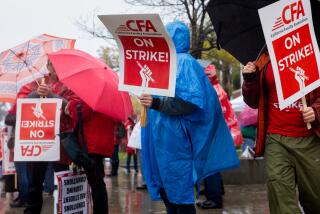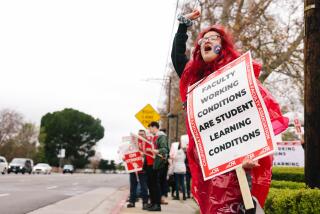Public university tuition is up, and the numbers zero in on why
Two reports released this weekend about how public universities are spending their money have sparked widespread outrage across the country.
One, from the Chronicle of Higher Education, outlined executive compensation at public universities, revealing that college presidents make, on average, nearly $500,000 a year. Nine presidents made more than $1 million in 2012-13, up from four the previous year.
The other report, from the Institute for Policy Studies, a left-leaning think tank in Washington, looked at executive pay, student debt and low-wage faculty labor at the 25 top-paying public universities. Of these schools, the ones with the highest-paid presidents also have seen student debt and part-time adjunct faculty increase far faster than the national averages.
But other recent studies indicate that rising executive pay isn’t what’s making public colleges and universities more expensive. Instead, it’s declining state support.
In the 1980s, states contributed most of the funds that public universities needed for higher education, Cornell professor Suzanne Mettler writes in her new book, “Degrees of Inequality: How Higher Education Politics Sabotaged the American Dream.”
The nation’s state universities and community colleges enroll 73% of all college students, but state governments decreased funding for those colleges and universities by an average of 26% from 1990 to 2009, she writes.
As state funding declined, colleges increased tuition 113% over the same time period.
To accompany an essay by Mettler about her findings, the Chronicle of Higher Education recently published an interactive chart showing how declining state support has affected colleges and universities.
The California numbers alone, pictured in the chart above, are sobering: In 1987, UC Davis got 63% of its revenues from the state. In 2012, it got just 30% of those revenues. UC Riverside now gets 33% of its revenues from the state, down from 66.6% in 1987. At UC Santa Barbara, state support fell to 23.4% from 54.1%; at UC Berkeley it fell to 22.6% from 49.4% in 1987 and at UCLA it fell to 22.2% from 49.4% in 1987.
Universities in other states saw even bigger decreases. The University of Illinois at Chicago now gets 16.9% of its revenues from the state, down from 52.8% in 1987; Georgia State now gets 35.2% from the state, down from 67% in 1987; the University of South Carolina at Columbia gets 21.6% of revenue from the state, down from 52.2% in 1987.
States are shifting funds away from higher education to elementary and secondary education as well as healthcare, Mettler writes, because laws forced them to provide services for residents in those areas, while higher education spending was considered discretionary. But those states are rewarded for cutting back on higher education because they get more federal aid, which is given to students who must pay higher tuition rates.
“In effect, states that game the system this way rely on taxpayers elsewhere in the nation to finance what they are unwilling to support for their own citizens,” Mettler writes.
Thomas Mortensen, a scholar at the Pell Institute for the Study of Opportunity in Higher Education, looked more specifically at how states have cut higher education spending. He found that Colorado reduced spending 69% from 1980 to 2011, from $16.72 of every $1,000 in state personal income to $3.11. Other states, including South Carolina, Rhode Island, Arizona and Oregon also reduced state support of higher education by more than 60%.
More to Read
Start your day right
Sign up for Essential California for news, features and recommendations from the L.A. Times and beyond in your inbox six days a week.
You may occasionally receive promotional content from the Los Angeles Times.







